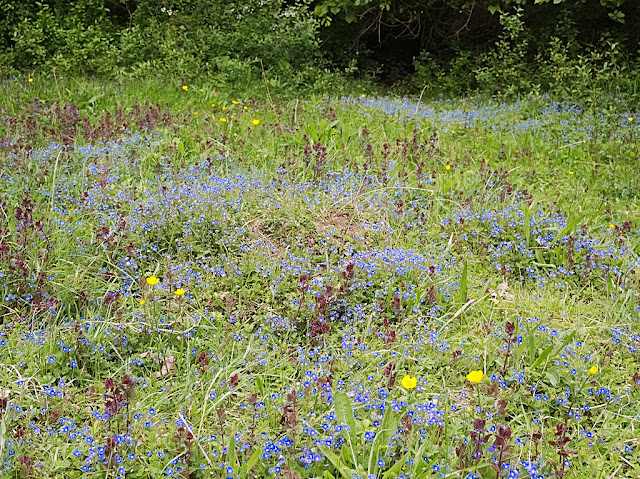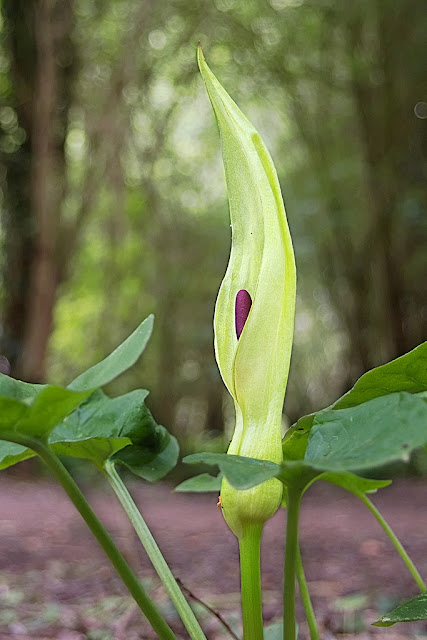a
I am taking a short break from writing this blog, partly because I don't have the time at the moment, and partly because I am unsure of the future direction of the blog. I feel that after two and a half years, I have thoroughly documented Milton Country Park, and don't necessarily think I have any more to say.
In fact, I was thinking of stopping the blog altogether until yesterday morning, when I took the dog for a walk around the park. Everything was bathed in a light mist, enough to obscure, but not thick enough to obliterate. I found the light inspirational, particularly as the moist air deadened the sound of traffic on the nearby dual carriageway. Unfortunately I didn't have a camera with me, as the dog is at an age where she demands too much attention.
Looking across Dickerson's Pit, I could see the shapes of the trees on the far bank, but the details had gone, and the colour was drained from the leaves. On the water, a couple of swans and a few seagulls loomed preternaturally large and white in the mist. On the ground, the leaves that had been ripped off the willows in the recent wind were rotting down to a mosaic of yellows, browns, purples and reds, turning the water of any puddles that had formed on top of them a light orange-red colour.
Everywhere I looked, I could see potential shots: bright yellow maple leaves which had fallen between sinuous dark tree roots; a forked tree overlooking the water; a clump of toadstools at the base of an old ivy covered willow; and a new view that had been opened up from the north end of Hall's Pond.
This has persuaded me to continue. The challenge is clearly greater, as I have already photographed the more obvious spots. But looking at the works of Edward Weston, Paul Strand, and Minor White, I am very tempted to seriously try some black and white photography, with its emphasis on tonality and form. And this is what I will be doing in my next post, hopefully, within the next month.
Friday, 20 October 2017
Saturday, 23 September 2017
Flower Meadow
A flower meadow in Milton Country Park? Not quite. Just two fairly small flower beds planted with an abundance of flowering annuals which reached their very colourful peak during July.
I talk about the garden reaching its peak in July, but in reality, it is more of a ridge than a peak. As these pictures show, by the beginning of July, the beds were very colourful, but predominantly white, with individual highlights of blue and purple.
As the month progressed, the density of the flowers increased and more pink and red appeared in the mix.
With a number of bright red poppies:
Finally, by the beginning of August, the bed becomes predominantly yellow with barely any white blossom at all:
After that, the display steadily declined as the flowers faded and died.
Next: October Colours
 |
| 9 July 2017 |
I talk about the garden reaching its peak in July, but in reality, it is more of a ridge than a peak. As these pictures show, by the beginning of July, the beds were very colourful, but predominantly white, with individual highlights of blue and purple.
 |
| 9 July 2017 |
As the month progressed, the density of the flowers increased and more pink and red appeared in the mix.
 |
| 16 July 2017 |
With a number of bright red poppies:
 |
| 16 July 2017 |
Finally, by the beginning of August, the bed becomes predominantly yellow with barely any white blossom at all:
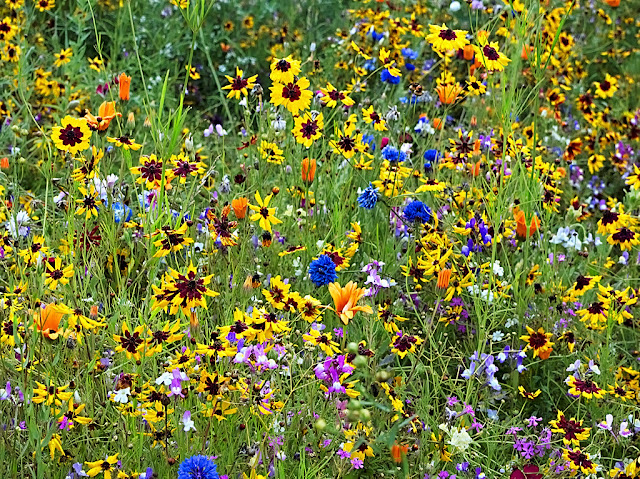 |
| 6 August 2017 |
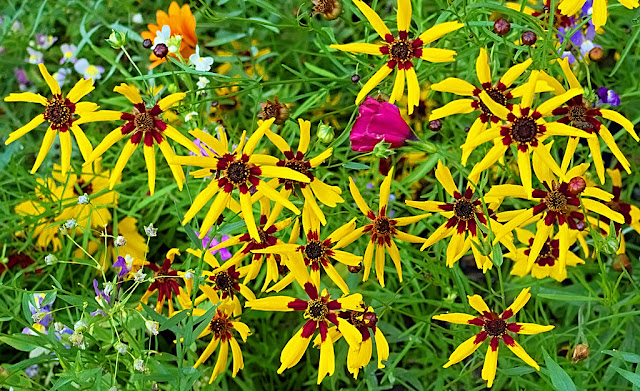 |
| 6 August 2017 |
After that, the display steadily declined as the flowers faded and died.
Next: October Colours
Saturday, 9 September 2017
Summer Surprise
It is well over two years now since I started intensively photographing Milton Country Park, yet this summer I came across two plants I had not seen before in the park: bee orchid and lady's bedstraw. This was only the second bee orchid I have ever seen, though the The Wildlife Trusts give its status as common throughout England.
The bee orchid is interesting, not only for its bee like flower, but also because it has evolved two separate mechanisms of pollination. The first is through bees that are lured to its bee-like flower with its promise of a mate. The second is self pollination. Unfortunately, the bee that the flower has so carefully evolved to mimic does not occur in England, and so the bee orchid is left to self pollinate. This means, that at the cost of some loss of genetic diversity, the bee orchid can extend its range beyond that of relevant bee.
Bird's foot trefoil gets its name from the arrangement of its black seed pods which is said to resemble a bird's claw. For a plant that seems to have no medicinal or culinary uses, and only minimal folklore, it has collected a huge collection of common names including: grandmother's slippers, ladies shoes, Gods almighty thumb and finger, kings fingers, granny's toenails, crow's toes, ladies shoes and stocking, bacon and eggs, and lady's slipper.
The other surprise was to find a clump of lady's bedstraw growing in the park. This is common enough on chalky ground, but is not normally seen in the rich peaty soil of the Cambridgeshire Fens. There is an interesting contrast between lady's bedstraw and bird's foot trefoil: both have minimal folklore associated with them; but where the trefoil has many alternative names, bedstraw has few; and where trefoil has almost no uses at all, the bedstraw was a really useful plant. As it's name suggests, it was used to fill mattresses, as a flea repellent, as a cheese coagulant, and to colour Double Gloucester cheese. Medicinally, it was used as a remedy for gout, epilepsy, and urinary tract infections.
The final plant I want to highlight in this post is St John's wort, or more specifically, woody St John's wort (Hypericum prolificum). As far as I am aware there is just a single plant of this flower on the North bank of Todd's Pit. Hypericum is a large varied genus including low growing herbs through to trees that reach a height of 12m. Confusingly, all members of the genus may be called St John's wort, derived from its flowering on St John's day - 23th June.
Next: Flower Meadow
 |
| Bee Orchid - 9 June 2017 All that wonderful mimicry wasted in England |
The bee orchid is interesting, not only for its bee like flower, but also because it has evolved two separate mechanisms of pollination. The first is through bees that are lured to its bee-like flower with its promise of a mate. The second is self pollination. Unfortunately, the bee that the flower has so carefully evolved to mimic does not occur in England, and so the bee orchid is left to self pollinate. This means, that at the cost of some loss of genetic diversity, the bee orchid can extend its range beyond that of relevant bee.
 |
| Site of Bee Orchid - 9 June 2017 Bee orchid barely visible in the bird's foot trefoil, ground ivy and grass |
Bird's Foot Trefoil
As the image above shows, the bee orchid that I photographed was in a mass of other plants including some bird's foot trefoil. In fact, I only spotted the bee orchid because I was trying to get a close up of the trefoil.
 |
| Bird's Foot Trefoil - 9 June 2017 |
Bird's foot trefoil gets its name from the arrangement of its black seed pods which is said to resemble a bird's claw. For a plant that seems to have no medicinal or culinary uses, and only minimal folklore, it has collected a huge collection of common names including: grandmother's slippers, ladies shoes, Gods almighty thumb and finger, kings fingers, granny's toenails, crow's toes, ladies shoes and stocking, bacon and eggs, and lady's slipper.
Lady's Bedstraw
 |
| Clump of Lady's Bedstraw - 9 July 2017 This clump was found growing among the nettles at the south end of the park |
The other surprise was to find a clump of lady's bedstraw growing in the park. This is common enough on chalky ground, but is not normally seen in the rich peaty soil of the Cambridgeshire Fens. There is an interesting contrast between lady's bedstraw and bird's foot trefoil: both have minimal folklore associated with them; but where the trefoil has many alternative names, bedstraw has few; and where trefoil has almost no uses at all, the bedstraw was a really useful plant. As it's name suggests, it was used to fill mattresses, as a flea repellent, as a cheese coagulant, and to colour Double Gloucester cheese. Medicinally, it was used as a remedy for gout, epilepsy, and urinary tract infections.
St John's Wort
 |
| St John's Wort - 14 June 2017 |
The final plant I want to highlight in this post is St John's wort, or more specifically, woody St John's wort (Hypericum prolificum). As far as I am aware there is just a single plant of this flower on the North bank of Todd's Pit. Hypericum is a large varied genus including low growing herbs through to trees that reach a height of 12m. Confusingly, all members of the genus may be called St John's wort, derived from its flowering on St John's day - 23th June.
Next: Flower Meadow
Saturday, 26 August 2017
Small and Beautiful
A single narrow leafed pea is flowering in the middle of a mass of cinquefoil, a purple counterpoint to the surrounding sea of yellow. The pea, approximately half a centimetre across, is a perfect scale model of its larger cousin and gardener's favourite, the sweet pea. Here, this tiny flower is noticed only by keen botanists and the photographer with his camera poised barely a centimetre above the ground.
The cinquefoil is colonising a heap of wood chippings, its stolons advancing on a broad front towards the top of the heap, dragging a wealth of yellow flowers, each the size of a buttercup, with it. At its leading edge, there is only cinquefoil. But farther back, other plants beside the pea are growing in the clump, including speedwell, white clover and, inevitably, grass. This is ecology in action, the first stage of a new plant community - where last year there were only wood chippings. Each species literally fighting for its place in sun. A contest with some collateral benefits, as all the flora will benefit from the nitrogen fixing activity of the clover.
Cinquefoil, a native of Britain, is seen by gardeners as an aggressive invader of lawns. In the past, it has been grown as a herb, particularly valued as an astringent used for cleaning wounds. It was believed to be an effective protection against witchcraft. Over the years, it has accumulated a number of alternative names, some of which, such as five fingers relate to the shape of its leaves. Others have a far less obvious origin: biscuits, bloodrot, ewe daisy, shepherds blood, and shepherds knapperty. Some of these are shared with the very similar tormentil, suggesting a degree of confusion between the two species.
Another invader of lawns and mown grass is the black medick. This yellow flowered relative of the clover, has flower heads about four millimetres across. But the flowers that I photographed were growing in recently cut and well trodden grass, and the whole flower head was little more than two millimetres across. The name medick is derived from the Latin name for the plant, Medicago lupulina, which in turn is derived from the Greek medike, meaning a plant that had been introduced from Media (modern Iran). Not surprisingly given its low growing habit and very small flowers, it is a plant that has been generally overlooked in folklore, with few recorded uses except as a source of honey. Some claim it is the original shamrock.
The small pale green flowers of the white bryony are easily missed in the thick foliage of a hedgerow at the height of summer, in contrast to its chains of red berries, also called devil's apples, which are a prominent feature of autumn. White bryony is also called English mandrake, and like the mandrake it has a forked anthropomorphic root. It is said, that just like the mandrake, that when a white bryony plant is pulled up, its screams are so monstrous they cause agony, if not death, to anyone within earshot. But English mandrake has none of the magical properties of mandrake, it is not soporific, hallucinogenic or aphrodisiac. However, white bryony has been used as a very powerful laxative, to cure gout, to induce mares to foal, and to keep rats away from stored wheat.
This year was the first time I have ever seen the small white flowers of cleavers. Like most other people, I knew this straggling annual from the smothering green blanket it forms over bushes and other vegetation and its habit of attaching itself to my clothing whenever I get too close. The tiny flowers born singly in the leaf axils are almost certainly the smallest things I have photographed so far in this project. Chris Packham in his book 'The Wild Side of Town' states that cleavers is insect pollinated. This seems quite amazing given that the flowers are almost vanishingly small.
Cleavers has long been used for various purposes: as bedding (Virgin Mary is reputed to have used it for the bed for the baby Jesus); the stems made into a mat and used to sieve milk; as a pot herb; its seeds used as a substitute coffee; its roots used as a source for red dye; and any number of medicinal uses including as a diuretic, a tonic, a sleeping draft, a cure for ear ache, and a remedy for snake bites. It has an equally impressive collection of alternative names: goosegrass, clivers, robin-run-in-the-hedge, love-man, sticky-willy, burweed, catchweed, and hedgesheriff.
a
Next: Summer Surprise
 |
| Narrow Leaved Pea - 31 May 2017 The yellow in the background is cinquefoil |
Cinquefoil
 |
| Cinquefoil Growing on Wood Chips - 31 May 2017 Some clover and grass can be seen in the cinquefoil at the bottom of the picture |
 |
| Cinquefoil - 9 June 2017 |
Cinquefoil, a native of Britain, is seen by gardeners as an aggressive invader of lawns. In the past, it has been grown as a herb, particularly valued as an astringent used for cleaning wounds. It was believed to be an effective protection against witchcraft. Over the years, it has accumulated a number of alternative names, some of which, such as five fingers relate to the shape of its leaves. Others have a far less obvious origin: biscuits, bloodrot, ewe daisy, shepherds blood, and shepherds knapperty. Some of these are shared with the very similar tormentil, suggesting a degree of confusion between the two species.
 |
| Germander Speedwell - 9 June 2017 A lone speedwell plant in the clump of cinquefoil |
Black Medick
 |
| Black Medick - 14 June 2017 The grass stems tower above this tiny herb |
Another invader of lawns and mown grass is the black medick. This yellow flowered relative of the clover, has flower heads about four millimetres across. But the flowers that I photographed were growing in recently cut and well trodden grass, and the whole flower head was little more than two millimetres across. The name medick is derived from the Latin name for the plant, Medicago lupulina, which in turn is derived from the Greek medike, meaning a plant that had been introduced from Media (modern Iran). Not surprisingly given its low growing habit and very small flowers, it is a plant that has been generally overlooked in folklore, with few recorded uses except as a source of honey. Some claim it is the original shamrock.
White Bryony
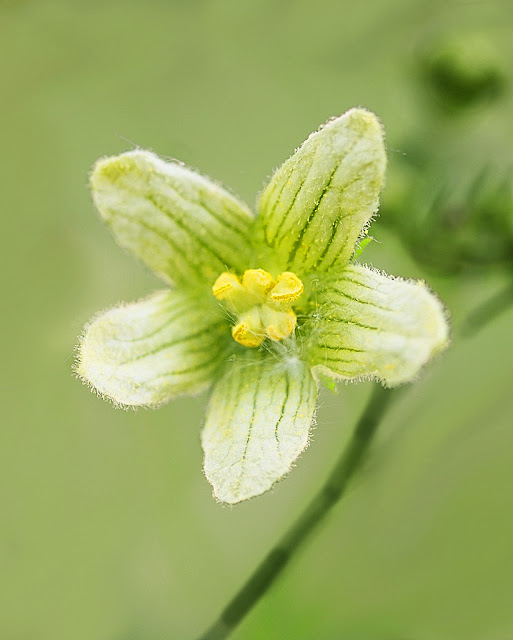 |
| White Bryony - 31 May 2017 |
The small pale green flowers of the white bryony are easily missed in the thick foliage of a hedgerow at the height of summer, in contrast to its chains of red berries, also called devil's apples, which are a prominent feature of autumn. White bryony is also called English mandrake, and like the mandrake it has a forked anthropomorphic root. It is said, that just like the mandrake, that when a white bryony plant is pulled up, its screams are so monstrous they cause agony, if not death, to anyone within earshot. But English mandrake has none of the magical properties of mandrake, it is not soporific, hallucinogenic or aphrodisiac. However, white bryony has been used as a very powerful laxative, to cure gout, to induce mares to foal, and to keep rats away from stored wheat.
Cleavers
 |
| Cleavers - 31 May 2017 Even close up the white flowers are almost invisible |
This year was the first time I have ever seen the small white flowers of cleavers. Like most other people, I knew this straggling annual from the smothering green blanket it forms over bushes and other vegetation and its habit of attaching itself to my clothing whenever I get too close. The tiny flowers born singly in the leaf axils are almost certainly the smallest things I have photographed so far in this project. Chris Packham in his book 'The Wild Side of Town' states that cleavers is insect pollinated. This seems quite amazing given that the flowers are almost vanishingly small.
Cleavers has long been used for various purposes: as bedding (Virgin Mary is reputed to have used it for the bed for the baby Jesus); the stems made into a mat and used to sieve milk; as a pot herb; its seeds used as a substitute coffee; its roots used as a source for red dye; and any number of medicinal uses including as a diuretic, a tonic, a sleeping draft, a cure for ear ache, and a remedy for snake bites. It has an equally impressive collection of alternative names: goosegrass, clivers, robin-run-in-the-hedge, love-man, sticky-willy, burweed, catchweed, and hedgesheriff.
a
Next: Summer Surprise
Monday, 14 August 2017
From Candles to Conkers
One of the delights of the English countryside in spring is the sight of a horse chestnut in flower, with its cones or 'candles' of white or pink blossom radiant against a background of the vibrant green of its newly unfolded leaves. It seems to be a visual megaphone, saying to the insect world, 'Here I am, I am in flower, come and pollinate me'. This is its moment of glory.
The horse chestnut is of course a foreigner, first introduced from the Balkans in the seventeenth century. Unsurprisingly, it quickly found favour with the landscape gardeners of the time. For instance, Christopher Wren redesigned Bushy Park specially to incorporate an avenue of these trees stretching from Teddington to Hampton Court. An avenue that Queen Victoria made an annual pilgrimage to visit and admire. Others were equally enamoured, including Capability Brown who planted 4800 chestnut trees in one estate in Tottenham alone.
The brash floral display of this newcomer total eclipses the far more subdued (O So British) flowers of the native trees like oak, ash, poplar and birch. But they are wind pollinated as every hay fever sufferer knows. They do not need to advertise themselves, and can have discrete brown or green catkins, reliant on nothing but the wind for the essential pollination.
But by August, the horse chestnut looks decidedly drab. The larvae of a leaf miner moth (for a picture and other details of the moth click here), which first appeared in Britain from Europe in 2003, tunnel into the leaves and turn them an unsightly brown. This infestation has reached epidemic proportions with well over half of all trees infected. Although the moth larvae are not fatal to the trees by themselves, they weaken their hosts and make them more susceptible to other pathogens. One pessimistic prognosis is that horse chestnuts could be virtually wiped out within 15 years.
The affects of the canker are well illustrated by a comparison of two horse chestnut trees in Milton Country Park. By August, the large tree by the entrance shown in the photograph above has a lot of damage. On the lower branches at least, I could only find one solitary conker. In contrast, on one of the trees planted in the last couple of years which shows very little leaf miner damage, there are any number of clumps of fruit with four or five conkers in each group.
Finally, in September, the fruit is ripe and falls to the ground to be collected as ammo for endless games of conkers.
The Phrase Finder: That Old Chestnut
Forestry Commission: Horse chestnut leaf miner - (Cameraria ohridella)
Country Living: Fact File: The Horse Chestnut Tree
UK Safari : Horse Chestnut Trees
Google Books: The Long Long Life of Trees
Daily Telegraph: Conkers Could Vanish Within 15 Years
Next: Small and Beautiful
 |
| Candles of Horse Chestnut Flowers - 11 May 2017 Few of these flowers will bear fruit due to the ravages of the leaf miner moth |
The horse chestnut is of course a foreigner, first introduced from the Balkans in the seventeenth century. Unsurprisingly, it quickly found favour with the landscape gardeners of the time. For instance, Christopher Wren redesigned Bushy Park specially to incorporate an avenue of these trees stretching from Teddington to Hampton Court. An avenue that Queen Victoria made an annual pilgrimage to visit and admire. Others were equally enamoured, including Capability Brown who planted 4800 chestnut trees in one estate in Tottenham alone.
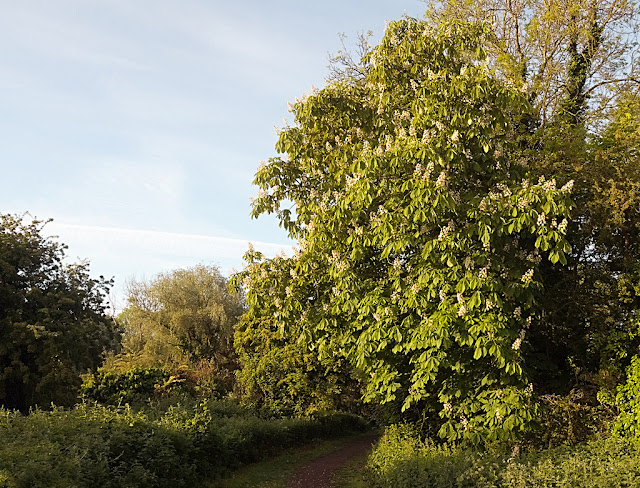 |
| Mature Tree - 21 May 2017 A mature tree in full bloom is an impressive site This tree by the Old School Lane entrance look very different in August |
The brash floral display of this newcomer total eclipses the far more subdued (O So British) flowers of the native trees like oak, ash, poplar and birch. But they are wind pollinated as every hay fever sufferer knows. They do not need to advertise themselves, and can have discrete brown or green catkins, reliant on nothing but the wind for the essential pollination.
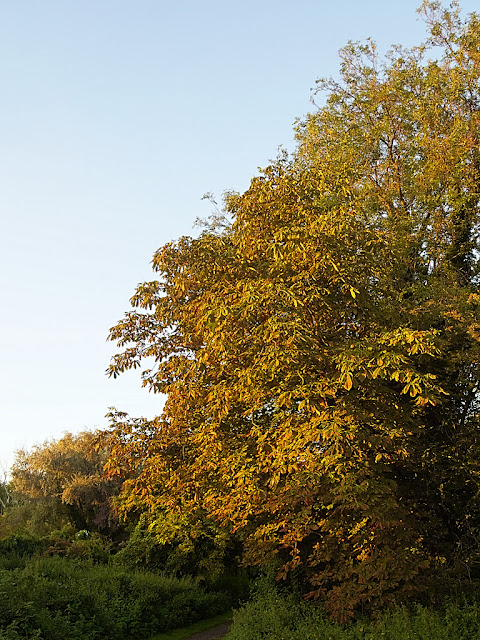 |
| Cankered Tree - 13 August 2017 The same tree as shown in the previous photograph showing the effects of the moth. |
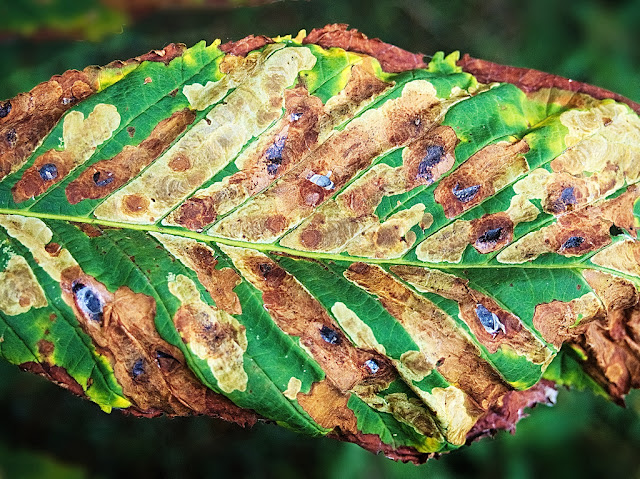 |
| Cankered Leaf - 11 August 2017 Leaf damage and black holes where the moth has hatched |
The affects of the canker are well illustrated by a comparison of two horse chestnut trees in Milton Country Park. By August, the large tree by the entrance shown in the photograph above has a lot of damage. On the lower branches at least, I could only find one solitary conker. In contrast, on one of the trees planted in the last couple of years which shows very little leaf miner damage, there are any number of clumps of fruit with four or five conkers in each group.
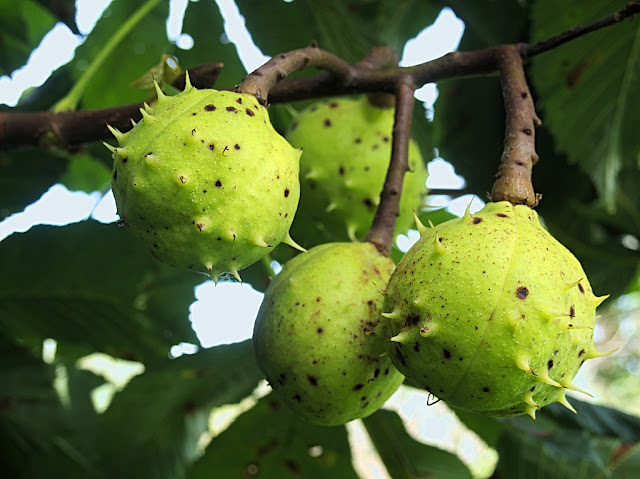 |
| Fruit on a Healthy Tree - 11 August 2017 One of many groups of conkers on a healthy tree |
Finally, in September, the fruit is ripe and falls to the ground to be collected as ammo for endless games of conkers.
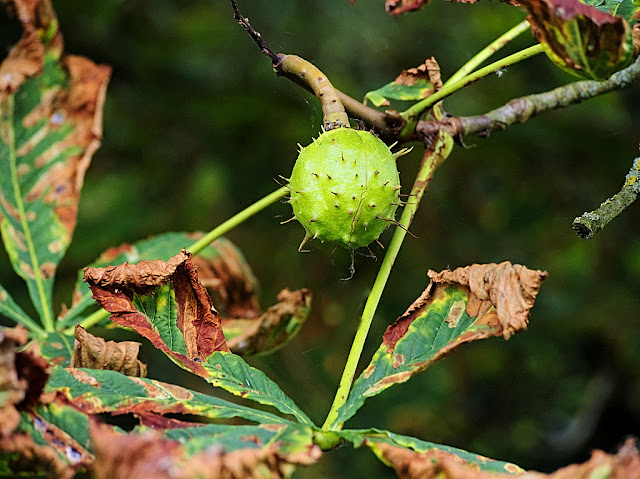 |
| Single Fruit on Damaged Tree - 11 August 2017 This was the only conker I could see on the lower branches of the large tree featured above |
And That Old Chestnut
One thing did puzzle me: where did the saying 'that old chestnut' come from? It apparently comes from an 1816 play by William Diamond. One of the players endlessly repeats a joke about a cork tree with only minor variations. His listener, bored with the 28th repetition, interrupts with the line "A Chestnut. I have heard you tell the joke 27 times and I'm sure it was a Chestnut!". The actor, William Warren, who played the listener later quoted the line at a dinner party when another guest started telling an old joke. From there, the phrase 'that old chestnut' passed into the language.Further Reading
UK Moths : Horse Chestnut Leaf-miner Cameraria ohridellaThe Phrase Finder: That Old Chestnut
Forestry Commission: Horse chestnut leaf miner - (Cameraria ohridella)
Country Living: Fact File: The Horse Chestnut Tree
UK Safari : Horse Chestnut Trees
Google Books: The Long Long Life of Trees
Daily Telegraph: Conkers Could Vanish Within 15 Years
Next: Small and Beautiful
Tuesday, 1 August 2017
May Day and Hawthorn Blossom
The
hawthorn flowered early and abundantly this year. The hedge shown in the photograph below was
covered with blossom in the first week of May, at least a fortnight earlier than the previous two years. Furthermore, a spell of settled weather meant that the flowers remained undamaged for an extended period of time
Hawthorn flowering at the beginning of May is unusual in modern times, but this was not always so. Traditionally, the blossom would be out on May 1 and be used as decoration for the May Day celebrations. But that tradition must have come to a shuddering halt in 1753. In 1752, the English calendar had been reformed to bring it into line with that of its continental neighbours, with a one off removal of 11 days from the year (the day after 2 September 1752 was the 14 September 1752). This meant, that in an average year, the hawthorn would not now flower until the middle of the month.
It must have been a strange May Day, and for many, a very disappointing one, in 1753. One of the big events in the calendar with a key component missing. It must have been a bit like Christmas without the lights would be to us.
At that time, England was not an industrialised nation, and most people earned their living working on the land. Live would not have been ruled by the clock and the calendar as it is today, but would have been tied to the natural world, its seasons and its weather. The lack of hawthorn blossom on May Day must have been one of the most obvious effects of the new calendar.
This year the hawthorn has again blossomed on May 1. Maybe, with climate change bringing milder winters, the old custom of 'gathering nuts in May' can be revived.
I have already photographed may blossom twice before, in 2015 and 2016, but that hasn't dampened my enthusiasm for taking pictures of these beautiful bushes.
One of things I wanted to achieve this year was better close-ups of the flowers, particularly the pink blossom. On some of the bushes, as the flowers age, they turn a delicate shade of pink. Inevitably, by the time the blooms are at their most pink, they are looking decidedly tired and weather worn.
Besides the drama of the hawthorn, May is the time of year when the trees are at their most verdant, and their green foliage is at its most varied. It ranges from the bright yellow green of some of the very newest shoots, to the darker, and more blue, of the ivy that envelops many of the trees in the park.
Another plant which adds very significantly to the whitening of the park at this time of year is the cow parsley. One area of grass beside the path that leads to the Fen Road exit is completely covered with this flower.
Next: From Candles to Conkers
 |
| Hedge in South of Park - 4 May 2017 |
Hawthorn flowering at the beginning of May is unusual in modern times, but this was not always so. Traditionally, the blossom would be out on May 1 and be used as decoration for the May Day celebrations. But that tradition must have come to a shuddering halt in 1753. In 1752, the English calendar had been reformed to bring it into line with that of its continental neighbours, with a one off removal of 11 days from the year (the day after 2 September 1752 was the 14 September 1752). This meant, that in an average year, the hawthorn would not now flower until the middle of the month.
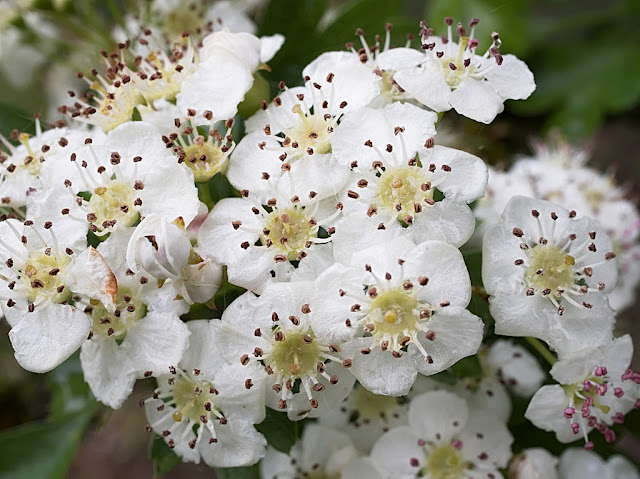 |
| White Hawthorn Blossom - 14 May 2017 |
It must have been a strange May Day, and for many, a very disappointing one, in 1753. One of the big events in the calendar with a key component missing. It must have been a bit like Christmas without the lights would be to us.
 |
| Pink Hawthorn Blossom - 14 May 2017 |
At that time, England was not an industrialised nation, and most people earned their living working on the land. Live would not have been ruled by the clock and the calendar as it is today, but would have been tied to the natural world, its seasons and its weather. The lack of hawthorn blossom on May Day must have been one of the most obvious effects of the new calendar.
This year the hawthorn has again blossomed on May 1. Maybe, with climate change bringing milder winters, the old custom of 'gathering nuts in May' can be revived.
 |
| Hawthorn Arch - 7 May 2017 |
I have already photographed may blossom twice before, in 2015 and 2016, but that hasn't dampened my enthusiasm for taking pictures of these beautiful bushes.
 |
| West Bank of Dickerson's Pit - 7 May 2017 |
One of things I wanted to achieve this year was better close-ups of the flowers, particularly the pink blossom. On some of the bushes, as the flowers age, they turn a delicate shade of pink. Inevitably, by the time the blooms are at their most pink, they are looking decidedly tired and weather worn.
 |
| Shades of Green - 4 May 2017 |
Besides the drama of the hawthorn, May is the time of year when the trees are at their most verdant, and their green foliage is at its most varied. It ranges from the bright yellow green of some of the very newest shoots, to the darker, and more blue, of the ivy that envelops many of the trees in the park.
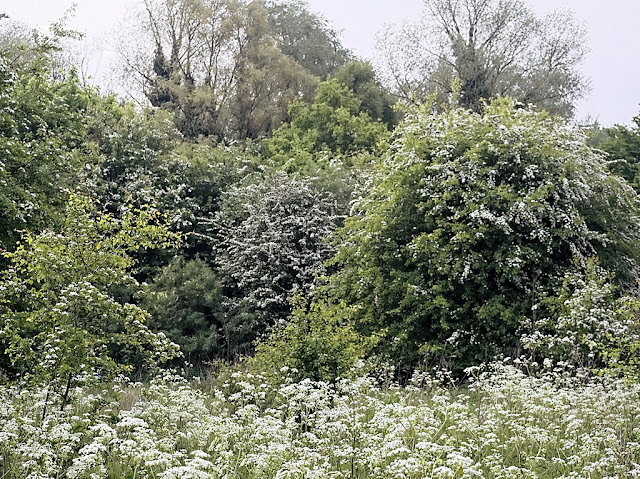 |
| Cow Parsley and Hawthorn - 7 May 2017 |
Another plant which adds very significantly to the whitening of the park at this time of year is the cow parsley. One area of grass beside the path that leads to the Fen Road exit is completely covered with this flower.
Further Reading
Mental Floss: Why Our Calendars Skipped 11 Days in 1752Next: From Candles to Conkers
Saturday, 22 July 2017
Laburnum
In late April and early May, Milton Country Park is white with hawthorn blossom. The only tree to break this hegemony of white is a solitary laburnum bush that grows besides the path as it winds it way along the east bank of Dickerson's Pit. Its branches arching over the path are heavy with long clusters of bright yellow flowers, fully justifying its alternative name of 'Golden Rain'.
But beware! This beautiful bush has a reputation for being highly poisonous. Although all parts of the bush are toxic, the main danger is to children who eat the seeds as they would eat peas. Symptoms range from nausea to, more frighteningly, convulsions, frothing at the mouth, and going into a coma. Fatalities are extremely rare.
As with many plants of late introduction into Britain, there is very little folklore associated with the laburnum, which was first cultivated here in the mid sixteenth century. One snippet that I found interesting, is that a laburnum will fail to flower if a neighbouring tree is removed.
My next tree, the medlar, certainly does not challenge the dominance of the hawthorn. A single tree is situated at the southern end of the orchard. Its blossom is almost hidden by its leaves, which are full grown by the time its single white flowers are out.
I have included in this post, not because of its visual impact, but because its name intrigues me. To me, it sounds medieval, conjuring up the age of chivalry, of knights in armour, and grand banquets. It is certainly old. The medlar, which has been cultivated for thousands of years, was first brought to England in the eleventh century.
But it is not possible to discuss the medlar's name without considering its fruit. 'Medlar' is thought to be derived from the French 'Medler', and means nothing more than the fruit of a small fruit bearing tree?!
One alternative name is 'open-arse' or 'openaers', derived either from the appearance, or the laxative properties of the fruit. The French also have an alternative name 'cul-de-chien' or 'Dogs Arse'.
It is with the more vulgar name that the medlar first found its way into English literature: in the prolog to the Reeves Tale, Chaucer uses the term 'open-ers' or 'openarse'. Later, Shakespeare was to use both 'medlar' and 'open-arse' in a single speech in Romeo and Juliet. In modern literature, D H Lawrence continued the faecal reference, when, in one poem, he described the medlar as: "Wineskins of brown morbidity, autumnal excrementa".
Another tree which flowers in late April or early May is the wayfaring tree. There are just a few of these tree in the hedgerows at the north end of the park, their white flowers overwhelmed and easily overlooked among the apple and hawthorn blossom. I only spotted them for the first time this April, after more than two years of paying close attention to the plant life in the park.
'Wayfaring Tree' is another of those traditional English names which I find so evocative. The name was given to it by Gerarde, describing its habit of growing by the wayside.
Next: May Day and Hawthorn Blossom
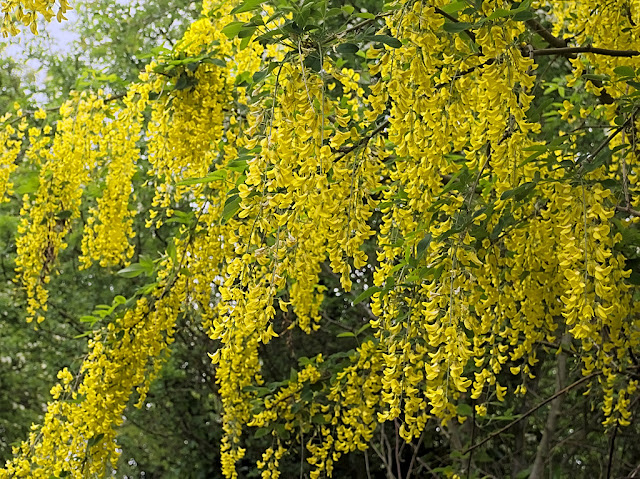 | |
| Golden Rain - 4 May 2017 This picture clearly shows how appropriate the name 'Golden Rain' is. |
But beware! This beautiful bush has a reputation for being highly poisonous. Although all parts of the bush are toxic, the main danger is to children who eat the seeds as they would eat peas. Symptoms range from nausea to, more frighteningly, convulsions, frothing at the mouth, and going into a coma. Fatalities are extremely rare.
 |
| Path besides Dickerson's Pit - 4 May 2017 The bright yellow flowers eclipse the white hawthorn behind. |
As with many plants of late introduction into Britain, there is very little folklore associated with the laburnum, which was first cultivated here in the mid sixteenth century. One snippet that I found interesting, is that a laburnum will fail to flower if a neighbouring tree is removed.
Medlar Tree
 |
| Medlar Flower - 11 May 2017 Single flowers are almost hidden among the full grown leaves |
My next tree, the medlar, certainly does not challenge the dominance of the hawthorn. A single tree is situated at the southern end of the orchard. Its blossom is almost hidden by its leaves, which are full grown by the time its single white flowers are out.
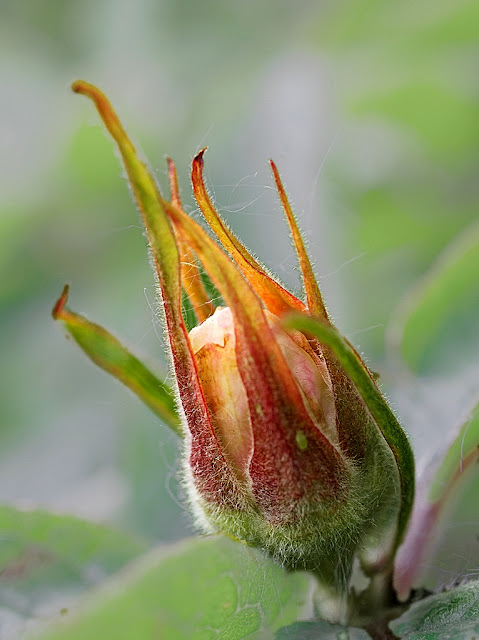 |
| Medlar Flower Bud - 11 May 2017 |
I have included in this post, not because of its visual impact, but because its name intrigues me. To me, it sounds medieval, conjuring up the age of chivalry, of knights in armour, and grand banquets. It is certainly old. The medlar, which has been cultivated for thousands of years, was first brought to England in the eleventh century.
But it is not possible to discuss the medlar's name without considering its fruit. 'Medlar' is thought to be derived from the French 'Medler', and means nothing more than the fruit of a small fruit bearing tree?!
 |
| Medlar Fruit - 6 September 2016 |
One alternative name is 'open-arse' or 'openaers', derived either from the appearance, or the laxative properties of the fruit. The French also have an alternative name 'cul-de-chien' or 'Dogs Arse'.
It is with the more vulgar name that the medlar first found its way into English literature: in the prolog to the Reeves Tale, Chaucer uses the term 'open-ers' or 'openarse'. Later, Shakespeare was to use both 'medlar' and 'open-arse' in a single speech in Romeo and Juliet. In modern literature, D H Lawrence continued the faecal reference, when, in one poem, he described the medlar as: "Wineskins of brown morbidity, autumnal excrementa".
Wayfaring Tree
 | |
| Wayfaring Tree Flower Head - 23 April 2017 |
Another tree which flowers in late April or early May is the wayfaring tree. There are just a few of these tree in the hedgerows at the north end of the park, their white flowers overwhelmed and easily overlooked among the apple and hawthorn blossom. I only spotted them for the first time this April, after more than two years of paying close attention to the plant life in the park.
 |
| Path by Wetlands - 23 April 2017 Wayfaring tree embedded in one of the hedges at the north end of the park |
'Wayfaring Tree' is another of those traditional English names which I find so evocative. The name was given to it by Gerarde, describing its habit of growing by the wayside.
Next: May Day and Hawthorn Blossom
Saturday, 8 July 2017
The Wisdom of Dandelions
It seems that almost every plant, no matter how small or insignificant, played a part in the world of our ancestors. Plants were used for food, for medicine, for protection against witches and evil spirits, and as good luck charms. They could foretell the future, forecast the weather, bring bad luck into the house, and act as link to the otherworld of pixies and fairies.
The dandelion - the name is from the old French dents-de-lion referring to the leaves whose shape resembles lions' teeth - has a reputation as something of an oracle. The flowers can be used to foretell everything from a child's future wealth to the true status of a woman's love, as well as forecasting the next day's weather. The seed heads are equally potent: blowing on the seed head can yield such diverse information as the time of day, the number of children a child will have, and the state of the blower's love life.
Germander Speedwell
If the dandelion flower is for the picking, my next flower, germander speedwell, definitely is not. To pick one of its tiny blue flowers was to risk having a bird peck one's eyes out; a belief presumably based on the resemblance of the flower with its dark blue periphery and white centre to a bird's eye. Except in Ireland, where it was sewn into clothes to protect against accidents!
In any case, the name 'germander speedwell' suggests happier assocations: 'speedwell' - a flower to speed the traveller on her way, cheered on by its masses of bright blue flowers.
Cuckoo Pint
The cuckoo pint (rhymes with mint, and is short for pintle a name for the penis) is the dirty postcard of the plant kingdom. The resemblance of its flowers, with their poker shaped spadix partially enclosed in a pale green hood or spathe, to human genitalia has titillated the imagination of generations. As a result, it has been called over 150 names including lords and ladies, devils and angels, boys and girls, naked boys, naked girls, and jack in the pulpit. The starch in its roots was used for stiffening altar clothes, church linen and Elizabethan ruffs.
Comfrey
Comfrey is an example of a plant cultivated for its medicinal properties. The name 'comfrey' , derived from the Latin 'con firma' to grow together, and other traditional names such as knitbone and boneset, reflect its value as an aid to the healing of broken bones. It has also been used as a poultice for bruises and to relieve arthritic pain, and a remedy for nappy rash.
White Dead Nettle
Finally, white dead nettle reveals how much pixies and fairies were part of the popular imagination. Its flowers, which occur in pairs, were said to be pixie shoes left outside their house. Maybe, the likeness can only be seen after drinking a distillation of the flowers which according to Gerard makes the 'heart merry' and 'restores the spirits'. From its alternative common names of 'deaf nettle', 'dumb nettle' and 'blind nettle', the white dead nettle is three wise monkeys all rolled into one plant!
Next: Laburnum
 |
| Dandelion - 25 April 2017 Though dandelions are abundant outside of Milton Country Park inside there are only a few clumps growing on the edge of paths. |
The dandelion - the name is from the old French dents-de-lion referring to the leaves whose shape resembles lions' teeth - has a reputation as something of an oracle. The flowers can be used to foretell everything from a child's future wealth to the true status of a woman's love, as well as forecasting the next day's weather. The seed heads are equally potent: blowing on the seed head can yield such diverse information as the time of day, the number of children a child will have, and the state of the blower's love life.
Germander Speedwell
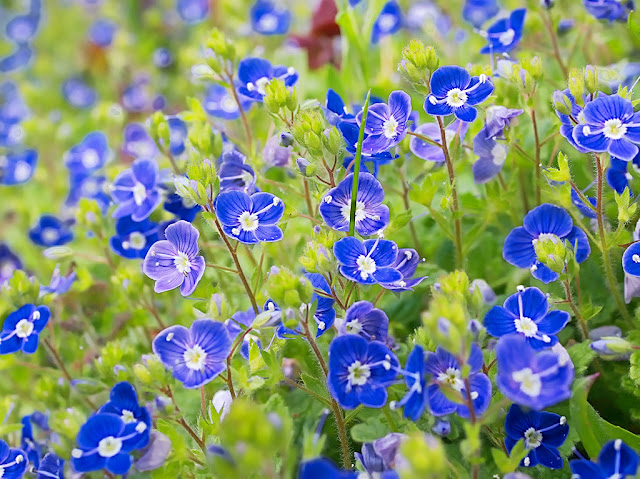 |
| Germander Speedwell - 25 April 2017 Close up the resemblance of the flower to birds' eyes is obvious Its alternative name is birds-eye trefoil |
If the dandelion flower is for the picking, my next flower, germander speedwell, definitely is not. To pick one of its tiny blue flowers was to risk having a bird peck one's eyes out; a belief presumably based on the resemblance of the flower with its dark blue periphery and white centre to a bird's eye. Except in Ireland, where it was sewn into clothes to protect against accidents!
In any case, the name 'germander speedwell' suggests happier assocations: 'speedwell' - a flower to speed the traveller on her way, cheered on by its masses of bright blue flowers.
Cuckoo Pint
The cuckoo pint (rhymes with mint, and is short for pintle a name for the penis) is the dirty postcard of the plant kingdom. The resemblance of its flowers, with their poker shaped spadix partially enclosed in a pale green hood or spathe, to human genitalia has titillated the imagination of generations. As a result, it has been called over 150 names including lords and ladies, devils and angels, boys and girls, naked boys, naked girls, and jack in the pulpit. The starch in its roots was used for stiffening altar clothes, church linen and Elizabethan ruffs.
Comfrey
 |
| Comfrey - 11 May 2017 In the woods in the south of the park, there is a large mass of comfrey growing either side of the path. |
Comfrey is an example of a plant cultivated for its medicinal properties. The name 'comfrey' , derived from the Latin 'con firma' to grow together, and other traditional names such as knitbone and boneset, reflect its value as an aid to the healing of broken bones. It has also been used as a poultice for bruises and to relieve arthritic pain, and a remedy for nappy rash.
White Dead Nettle
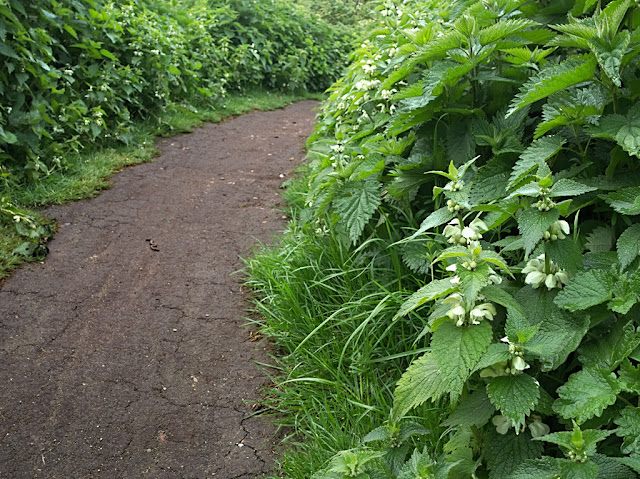 |
| White Dead Nettle - 17 April 2017 Up to this year, there have been just a few clumps of this plant in the park, this year it lines the bike tracks at the south of the park. |
Further Reading
I have listed all my sources for this post on a separate page 'Folklore References'Next: Laburnum
Saturday, 24 June 2017
Apple Blossom
My camera and I disagree about apple blossom. We agree that close up the individual flowers with five white petals tinged with pink are among the most beautiful of the springtime tree blossom. We disagree about the impact the flowering of the apple trees has on the landscape of Milton Country Park in general, and its orchard in particular.
This has been a good year for blossom and the orchard has been the prettiest I have seen it. To my eye, the apple blossom was plentiful and stood out from the background. The camera saw things somewhat differently: the blossom was there, but was only one of a number of elements competing for my attention in the final picture.
This is not the first time in the course of this project that I have come up against this phenomenum whereby the visual weight of an item is completely reduced, even though the proportion it occupies in the final picture is probably greater than it was in the original scene. It underlines how the brain interprets a picture completely differently from the way it interprets the image formed on the retina by the original landscape.
Over the ages, the apple has featured prominantly in myths and legends, which is hardly surprising given that there is evidence that man has been eating apples for over 7000 years. Here, I want to highlight some of the folklore that is specifically associated with apple blossom.
In China, apple blossom symbolises a woman's beauty. In other cultures, the flowers are associated with love, and have been included in love sachets and candles to attract love. In Wales, apple blossom was laid in coffins to restore youth in the afterlife.
I finish with a bit of English weather lore:
If apples bloom in March
In vain for them you'll search;
If apples bloom in April
Why then, they'll be plentiful;
If apples bloom in May
You can eat them night and day.
From that, it appears that 2017 should be a good year for apples!
Apple History, Folklore, Myth and Magic
Tree Lore: Apple
Apple Folklore
The Magic of the Ogham Trees: Apple - Quert
Fruit in Mythology
Next : The Wisdom of Dandelions
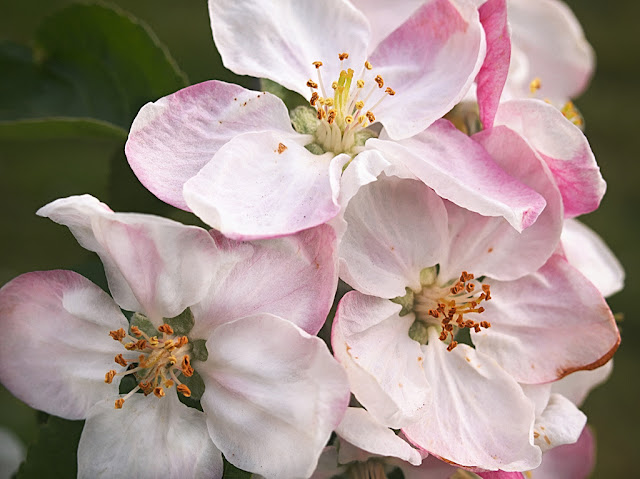 |
| Apple Blossom - 23 April 2017 White petals with pink tinge and underside |
This has been a good year for blossom and the orchard has been the prettiest I have seen it. To my eye, the apple blossom was plentiful and stood out from the background. The camera saw things somewhat differently: the blossom was there, but was only one of a number of elements competing for my attention in the final picture.
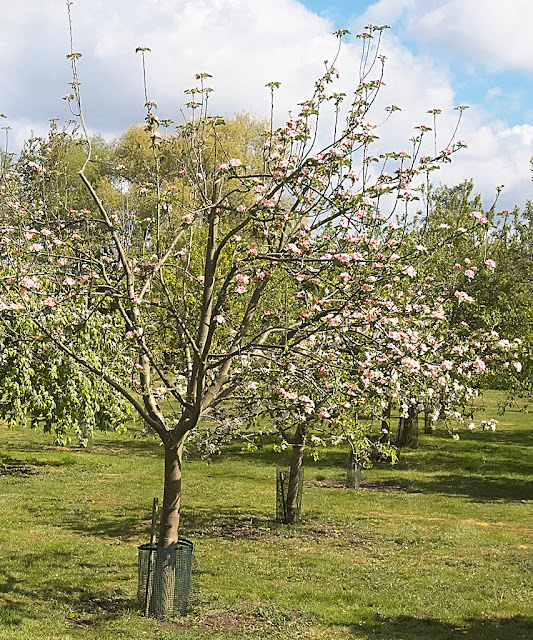 |
| Orchard - 25 April 2017 Apple blossom at its peak. The bare branches and the metal guards around the trunks seem far more prominent than I remember them |
This is not the first time in the course of this project that I have come up against this phenomenum whereby the visual weight of an item is completely reduced, even though the proportion it occupies in the final picture is probably greater than it was in the original scene. It underlines how the brain interprets a picture completely differently from the way it interprets the image formed on the retina by the original landscape.
 | |
| Path by Wetlands - 16 April 2017 Apple tree growing by the path which seemed far more obvious than it does in this image. |
Folklore
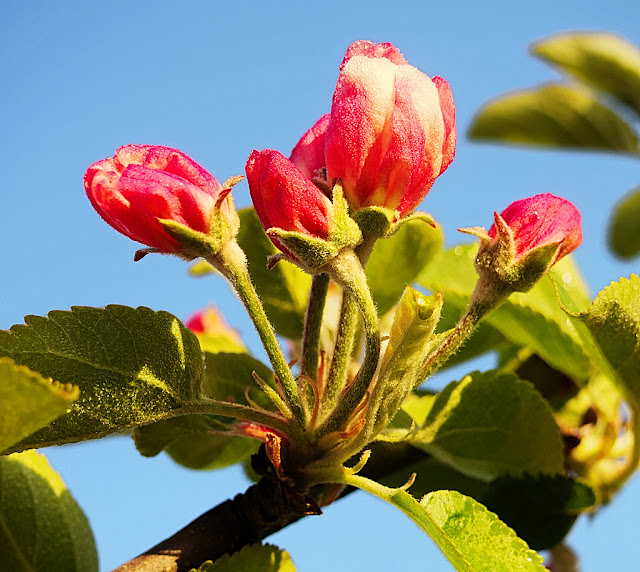 |
| Buds - 9 April 2017 The buds on this tree were a very deep pink, almost red |
Over the ages, the apple has featured prominantly in myths and legends, which is hardly surprising given that there is evidence that man has been eating apples for over 7000 years. Here, I want to highlight some of the folklore that is specifically associated with apple blossom.
 |
| Blossom - 23 April 2017 Its not difficult to see why apple blossom should symbolize a woman's beauty |
In China, apple blossom symbolises a woman's beauty. In other cultures, the flowers are associated with love, and have been included in love sachets and candles to attract love. In Wales, apple blossom was laid in coffins to restore youth in the afterlife.
 |
| Apple Blossom - 23 April 2017 Catch a falling petal to bring you luck Catch twelve for a year of good fortune |
I finish with a bit of English weather lore:
If apples bloom in March
In vain for them you'll search;
If apples bloom in April
Why then, they'll be plentiful;
If apples bloom in May
You can eat them night and day.
From that, it appears that 2017 should be a good year for apples!
Further Reading
Fresh Fruit Facts and FolkloreApple History, Folklore, Myth and Magic
Tree Lore: Apple
Apple Folklore
The Magic of the Ogham Trees: Apple - Quert
Fruit in Mythology
Next : The Wisdom of Dandelions
Labels:
Apple Blossom,
Apples,
April,
Folk Lore,
May,
Milton Country Park,
Orchard
Subscribe to:
Posts (Atom)


